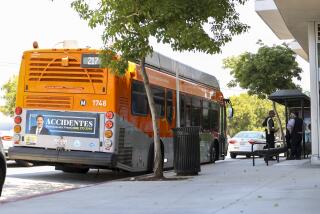Panel OKs Report on Transportation Needs in Region
- Share via
After three years of study, a regional committee of political and community leaders has approved a report calling for a variety of public transportation improvements in the northeast area of Los Angeles.
In action taken Friday, the advisory committee to the Southern California Assn. of Governments concluded that a voluntary, areawide task force should be formed to work for more than $1.2 billion in new transportation developments and services in the next 20 years.
Improvements would include a light-rail system through Highland Park, transit stations in Mt. Washington and Eagle Rock and additional lanes and ramp modifications on freeways serving the area.
Community leaders were warned on Friday that old rights of way once used by trolleys still exist on many streets through the area but could be lost with new development and changes in roadways.
Transit corridors still in effect but jeopardized include a Pacific Electric right of way along Glendale Boulevard in the Silver Lake area and the former Yellow Car right of way along Eagle Rock and Colorado boulevards, according to the SCAG study.
Transit stations proposed in the report include one at Avenue 26 and the Santa Fe railroad tracks near the Golden State and Pasadena freeways interchange and another at Figueroa Street and Colorado Boulevard in Eagle Rock.
Adoption of the report was the final action of the advisory committee, formed in November, 1987, and composed of representatives of the communities of East Los Angeles, Boyle Heights, Lincoln Heights, El Sereno, Highland Park and Eagle Rock. Also participating in the East Los Angeles-West San Gabriel Valley Area Transportation Study were the cities of South Pasadena, Alhambra, Monterey Park and Pasadena.
Los Angeles City Councilman Richard Alatorre served as committee chairman. Results of the study will be used by SCAG for long-range, regional transportation planning, officials said.
Diana Barnwell, a Mt. Washington activist and member of the advisory committee, called the railroad and right-of-way studies included in the report “a very viable and exciting alternative” for solving traffic congestion. However, she criticized the report for failing to pursue alternatives in further detail rather than emphasizing the need to extend and expand freeways.
“I feel that we were really shortchanged in that respect,” Barnwell said. “There are long, intact, logical routes that intersect the plan area.” Despite her criticism, Barnwell said she endorsed the report because “it is very pregnant with ideas” and “has components that could really work.”
Councilwoman Evelyn Fierro of South Pasadena was one of only two committee members who rejected the report because she said it serves as nothing more than an endorsement to complete the controversial Long Beach Freeway through El Sereno and her community. Opponents for more than 15 years have blocked construction, which would destroy 1,500 residences, including many historical sites.
A representative of state Sen. Art Torres (D-Los Angeles), who represents the area, also opposed adoption of the study.
While Fierro said she supports elements of the study, particularly as it relates to light-rail planning, she angrily denounced the report as a “rather superficial study.” She accused Alatorre of using the committee and the study to push for completion of the Long Beach Freeway.
She said she is particularly disturbed that the cities of Alhambra, Monterey Park and Pasadena voted in favor of the freeway project because they “are not even touched by it. How dare they!”
However, a deputy to Alatorre defended the councilman’s action, saying the freeway debate grew out of the study.
Bonnie Brody, Alatorre’s specialist on the transportation study, said a modeling plan developed by SCAG showed that “unless the Long Beach Freeway was completed, congestion was going to be a total disaster.” She called complaints that Alatorre is using the committee’s action to pressure federal and state officials to complete the freeway “just not true.”
But Brody said Alatorre’s involvement in the study helped give him a powerful voice in local transit decisions through his appointments to the Los Angeles County Transportation Commission, which allocates transportation funds, and to the board of the Southern California Rapid Transit District.
Officials said many elements of the three-year-old study are now outdated. The Highland Park light-rail route along the Santa Fe tracks, for instance, was funded last year by the county commission for construction in 1995 as an extension of the already operating Long Beach-to-Los Angeles Blue Line.
But they said the cooperative spirit developed among representatives of six independent jurisdictions is a start toward meeting the transportation needs of 650,000 residents in a 10-square-mile area.
“The relationships will stay,” Brody said. “And that is valuable.”
More to Read
Sign up for Essential California
The most important California stories and recommendations in your inbox every morning.
You may occasionally receive promotional content from the Los Angeles Times.













